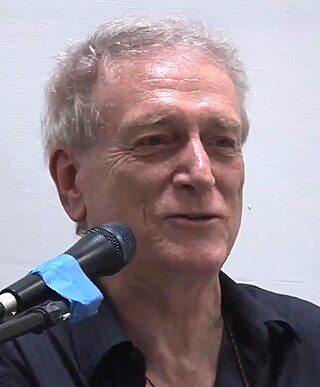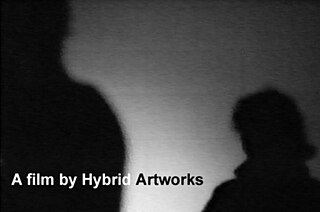Video art is an art form which relies on using video technology as a visual and audio medium. Video art emerged during the late 1960s as new consumer video technology such as video tape recorders became available outside corporate broadcasting. Video art can take many forms: recordings that are broadcast; installations viewed in galleries or museums; works either streamed online, or distributed as video tapes, or on DVDs; and performances which may incorporate one or more television sets, video monitors, and projections, displaying live or recorded images and sounds.

Wolf Vostell was a German painter and sculptor, considered one of the early adopters of video art and installation art and pioneer of Happenings and Fluxus. Techniques such as blurring and Dé-coll/age are characteristic of his work, as is embedding objects in concrete and the use of television sets in his works. Wolf Vostell was married to the Spanish writer Mercedes Vostell and has two sons, David Vostell and Rafael Vostell.

Installation art is an artistic genre of three-dimensional works that are often site-specific and designed to transform the perception of a space. Generally, the term is applied to interior spaces, whereas exterior interventions are often called public art, land art or art intervention; however, the boundaries between these terms overlap.

Nam June Paik was a Korean artist. He worked with a variety of media and is considered to be the founder of video art. He is credited with the first use (1974) of the term "electronic super highway" to describe the future of telecommunications.

Gary Hill is an American artist who lives and works in Seattle, Washington. Often viewed as one of the foundational artists in video art, based on the single-channel work and video- and sound-based installations of the 1970s and 1980s, he in fact began working in metal sculpture in the late 1960s. Today he is best known for internationally exhibited installations and performance art, concerned as much with innovative language as with technology, and for continuing work in a broad range of media. His longtime work with intermedia explores an array of issues ranging from the physicality of language, synesthesia and perceptual conundrums to ontological space and viewer interactivity. The recipient of many awards, his influential work has been exhibited in most major contemporary art museums worldwide.
Stephen Vitiello is an American visual and sound artist. Originally a punk guitarist he is influenced by video artist Nam June Paik who he worked with after meeting in 1991. He has collaborated with Pauline Oliveros, Robin Rimbaud and Frances-Marie Uitti; as well as visual artists Julie Mehretu, Tony Oursler and Joan Jonas.
Tony Oursler is an American multimedia and installation artist married to Jacqueline Humphries. He completed a Bachelor of Fine Arts at the California Institute for the Arts, Valencia, California, in 1979. His art covers a range of mediums, working with video, sculpture, installation, performance, and painting. He lives and works in New York City.

Doug Aitken is an American multidisciplinary artist. Aitken's body of work ranges from photography, print media, sculpture, and architectural interventions, to narrative films, sound, single and multi-channel video works, installations, and live performance. He currently lives in Venice, California, and New York City.

George Quasha is an American artist and poet who works across media, exploring language, sculpture, drawing, video art, sound and music, installation, and performance. He lives and works in Barrytown, New York.

A video sculpture is a type of video installation that integrates video into an object, environment, site or performance. The nature of video sculpture is that it utilizes the material of video in an innovative way in space and time, different from the standard traditional narrative screening where the video has a beginning and end.
Peter Sarkisian is an American new media artist based in Santa Fe, New Mexico. He combines video projection and sculpture to create hybrid-format, multi-media installations.
Tony Martin was an American painter and new media artist known for his groundbreaking light art and viewer interactive sculptures and installations, and the paintings associated with those works. His six decade painting career includes expressionistic figural work and abstraction developed from his life and environs.
Paul Sermon was born 23 March 1966, in Oxford, England. Since September 2013 he has worked as Professor of Visual Communication in the Faculty of Arts at the University of Brighton.
Raphaele Shirley is a French-American multi-media artist. She has been working at the intersection of the art and technology since 1993. Her practices include sculpture, light art, public art, collaborative works and performance. Her works have been documented and reviewed in publications such as the Art Newspaper, Art in America, Art Forum, and Canvas Magazine.
Electronic Arts Intermix (EAI) is a nonprofit arts organization that is a resource for video and media art. An advocate of media art and artists since 1971, EAI's core program is the distribution and preservation of a collection of over 3,500 new and historical video works by artists. EAI has supported the creation, exhibition, distribution and preservation of video art, and more recently, digital art projects.

Hybrid Artworks is an interdisciplinary research and performance art cooperative originally based in Hull, UK. It was established in 1995 and produced pieces of performance art, video installation theatre, texts and essays.

Vertical Roll is a 1972 video art piece by American video and performance artist Joan Jonas. It is a sequel to Jonas' first video work Organic Honey's Visual Telepathy. Jonas' interfacing with the material grammar of video was significant to the late 1960s and early 1970s experimentation with new video technology. Among others, Steina and Woody Vasulka, Nam June Paik and Peter Campus also contributed to the emergent material discourse of video art.

Judith Barry is an American multimedia artist, writer and educator. Art critics regard her as a pioneer in performance art, video, electronic media and installation art who has contributed significantly to feminist theories of subjectivity and the exploration of public constructions of gender and identity. Her work draws on a diverse background, which includes studies in critical theory and cinema, dance, and training in architecture, design and computer graphics. Rather than employ a signature style, Barry combines multiple disciplines and mediums in immersive, research-based works whose common methodology calls into question technologies of representation and the spatial languages of film, urbanism and the art experience. Critic Kate Linker wrote, "Barry has examined the effects and ideological functions of images in and on society. Her installations and writings … have charted the transformation of representation by different 'machines' of image production, from the spatial ensembles of theater to computer and electronic technologies."
Single-channel video is a video art work using a single electronic source, presented and exhibited from one playback device. Electronic sources can be any format of video tape, DVDs or computer-generated moving images utilizing the applicable playback device and exhibited using a television monitor, projection or other screen-based device. Historically, video art was limited to unedited video tape footage displayed on a television monitor in a gallery and was conceptually contrasted with both broadcast television and film projections in theatres. As technology advanced, the ability to edit and display video art provided more variations and multi-channel video works became possible as did multi-channel and multi-layered video installations. However, single-channel video works continue to be produced for a variety of aesthetic and conceptual reasons and the term usually now refers to a single image on a monitor or projection, regardless of image source or production.









